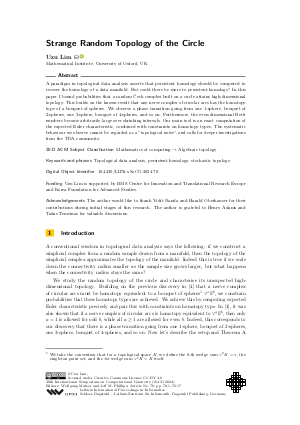Strange Random Topology of the Circle
Author
Uzu Lim 
-
Part of:
Volume:
40th International Symposium on Computational Geometry (SoCG 2024)
Part of: Series: Leibniz International Proceedings in Informatics (LIPIcs)
Part of: Conference: Symposium on Computational Geometry (SoCG) - License:
 Creative Commons Attribution 4.0 International license
Creative Commons Attribution 4.0 International license
- Publication Date: 2024-06-06
File

PDF
LIPIcs.SoCG.2024.70.pdf
- Filesize: 0.76 MB
- 17 pages
Document Identifiers
Subject Classification
ACM Subject Classification
- Mathematics of computing → Algebraic topology
Keywords
- Topological data analysis
- persistent homology
- stochastic topology
Metrics
- Access Statistics
-
Total Accesses (updated on a weekly basis)
0PDF Downloads0Metadata Views
Abstract
A paradigm in topological data analysis asserts that persistent homology should be computed to recover the homology of a data manifold. But could there be more to persistent homology? In this paper I bound probabilities that a random m Čech complex built on a circle attains high-dimensional topology. This builds on the known result that any nerve complex of circular arcs has the homotopy type of a bouquet of spheres. We observe a phase transition going from one 1-sphere, bouquet of 2-spheres, one 3-sphere, bouquet of 4-spheres, and so on. Furthermore, the even-dimensional Betti numbers become arbitrarily large over shrinking intervals. Our main tool is an exact computation of the expected Euler characteristic, combined with constraints on homotopy types. The systematic behaviour we observe cannot be regarded as a "topological noise", and calls for deeper investigations from the TDA community.
Cite As Get BibTex
Uzu Lim. Strange Random Topology of the Circle. In 40th International Symposium on Computational Geometry (SoCG 2024). Leibniz International Proceedings in Informatics (LIPIcs), Volume 293, pp. 70:1-70:17, Schloss Dagstuhl – Leibniz-Zentrum für Informatik (2024)
https://doi.org/10.4230/LIPIcs.SoCG.2024.70
BibTex
@InProceedings{lim:LIPIcs.SoCG.2024.70,
author = {Lim, Uzu},
title = {{Strange Random Topology of the Circle}},
booktitle = {40th International Symposium on Computational Geometry (SoCG 2024)},
pages = {70:1--70:17},
series = {Leibniz International Proceedings in Informatics (LIPIcs)},
ISBN = {978-3-95977-316-4},
ISSN = {1868-8969},
year = {2024},
volume = {293},
editor = {Mulzer, Wolfgang and Phillips, Jeff M.},
publisher = {Schloss Dagstuhl -- Leibniz-Zentrum f{\"u}r Informatik},
address = {Dagstuhl, Germany},
URL = {https://drops.dagstuhl.de/entities/document/10.4230/LIPIcs.SoCG.2024.70},
URN = {urn:nbn:de:0030-drops-200150},
doi = {10.4230/LIPIcs.SoCG.2024.70},
annote = {Keywords: Topological data analysis, persistent homology, stochastic topology}
}
Author Details
Funding
Uzu Lim is supported by BMS Centre for Innovation and Translational Research Europe and Korea Foundation for Advanced Studies.
Acknowledgements
The author would like to thank Vidit Nanda and Harald Oberhauser for their contributions during initial stages of this research. The author is grateful to Henry Adams and Tadas Temčinas for valuable discussions.
References
-
Michał Adamaszek and Henry Adams. The vietoris-rips complexes of a circle. Pacific Journal of Mathematics, 290(1):1-40, 2017.

-
Michał Adamaszek and Henry Adams. On vietoris-rips complexes of hypercube graphs. Journal of Applied and Computational Topology, 6(2):177-192, 2022.

-
Michał Adamaszek, Henry Adams, and Florian Frick. Metric reconstruction via optimal transport. SIAM Journal on Applied Algebra and Geometry, 2(4):597-619, 2018.

-
Michał Adamaszek, Henry Adams, Florian Frick, Chris Peterson, and Corrine Previte-Johnson. Nerve complexes of circular arcs. Discrete & Computational Geometry, 56:251-273, 2016.

-
Michał Adamaszek, Henry Adams, and Francis Motta. Random cyclic dynamical systems. Advances in Applied Mathematics, 83:1-23, 2017.

-
Michał Adamaszek, Henry Adams, and Samadwara Reddy. On vietoris-rips complexes of ellipses. Journal of Topology and Analysis, 11(03):661-690, 2019.

- Henry Adams, Samir Chowdhury, Adam Quinn Jaffe, and Bonginkosi Sibanda. Vietoris-rips complexes of regular polygons. arXiv preprint, 2018. URL: https://arxiv.org/abs/1807.10971.
-
Omer Bobrowski and Matthew Kahle. Topology of random geometric complexes: a survey. Journal of applied and Computational Topology, 1:331-364, 2018.

-
Omer Bobrowski and Goncalo Oliveira. Random čech complexes on riemannian manifolds. Random Structures & Algorithms, 54(3):373-412, 2019.

-
Omer Bobrowski and Shmuel Weinberger. On the vanishing of homology in random čech complexes. Random Structures & Algorithms, 51(1):14-51, 2017.

-
Peter Bubenik and Peter T Kim. A statistical approach to persistent homology. Homology, homotopy and Applications, 9(2):337-362, 2007.

-
Henry-Louis de Kergorlay, Ulrike Tillmann, and Oliver Vipond. Random čech complexes on manifolds with boundary. Random Structures & Algorithms, 61(2):309-352, 2022.

-
Jean-Claude Hausmann et al. On the vietoris-rips complexes and a cohomology theory for metric spaces. Annals of Mathematics Studies, 138:175-188, 1995.

-
Matthew Kahle. Random geometric complexes. Discrete & Computational Geometry, 45:553-573, 2011.

- Sunhyuk Lim, Facundo Memoli, and Osman Berat Okutan. Vietoris-rips persistent homology, injective metric spaces, and the filling radius. arXiv preprint, 2020. URL: https://arxiv.org/abs/2001.07588.
-
Partha Niyogi, Stephen Smale, and Shmuel Weinberger. Finding the homology of submanifolds with high confidence from random samples. Discrete & Computational Geometry, 39:419-441, 2008.

-
Taejin Paik and Otto van Koert. Expected invariants of simplicial complexes obtained from random point samples. Archiv der Mathematik, 120(4):417-429, 2023.

-
Mathew Penrose. Random geometric graphs, volume 5. OUP Oxford, 2003.

-
WL Stevens. Solution to a geometrical problem in probability. Annals of Eugenics, 9(4):315-320, 1939.

-
Andrew M Thomas and Takashi Owada. Functional limit theorems for the euler characteristic process in the critical regime. Advances in Applied Probability, 53(1):57-80, 2021.

